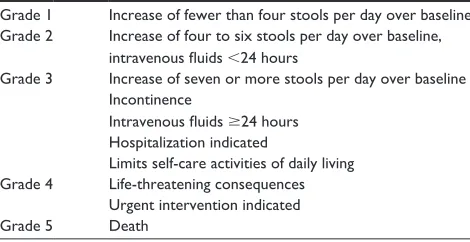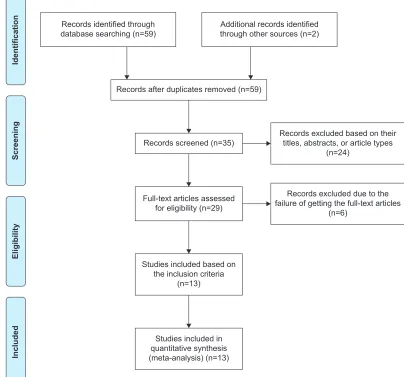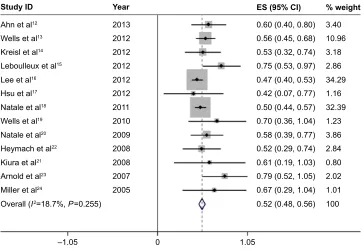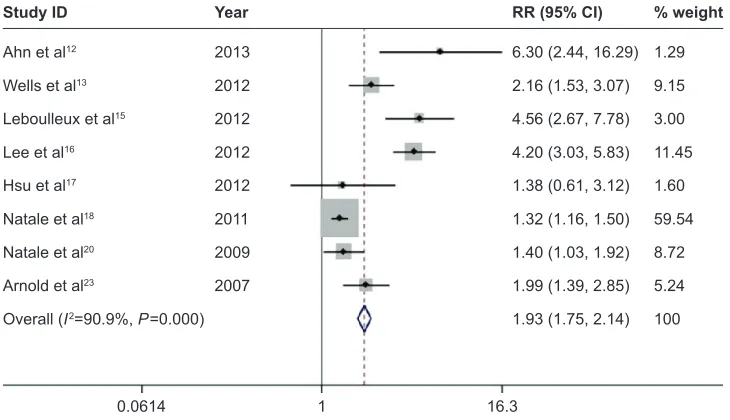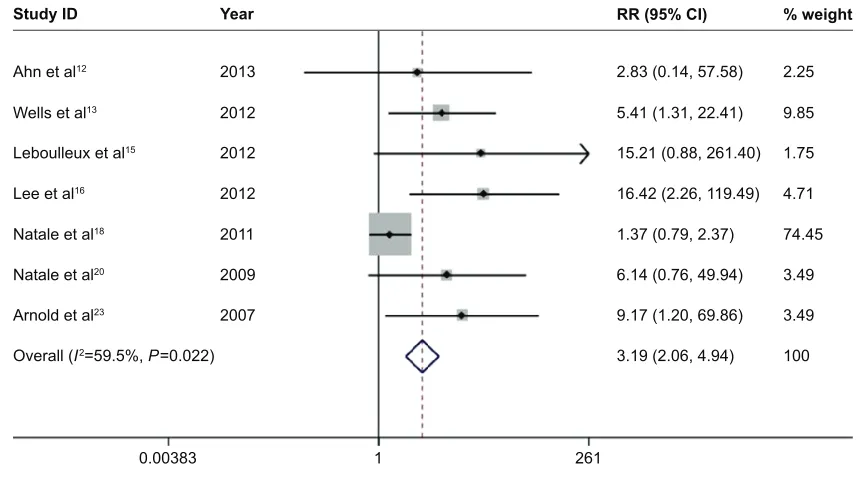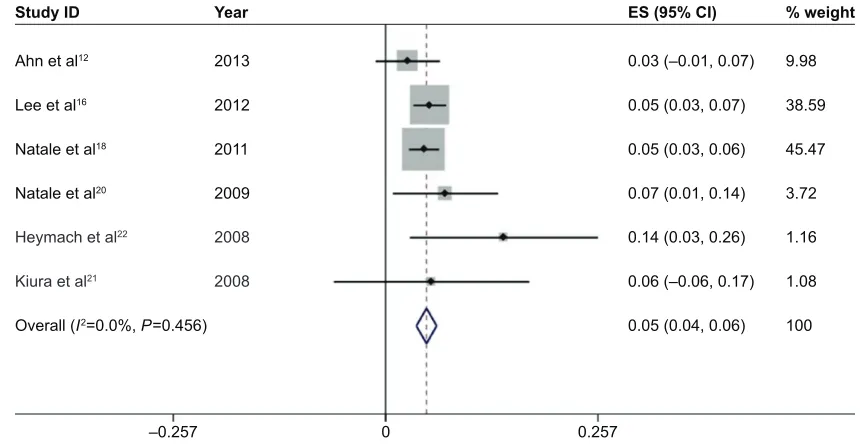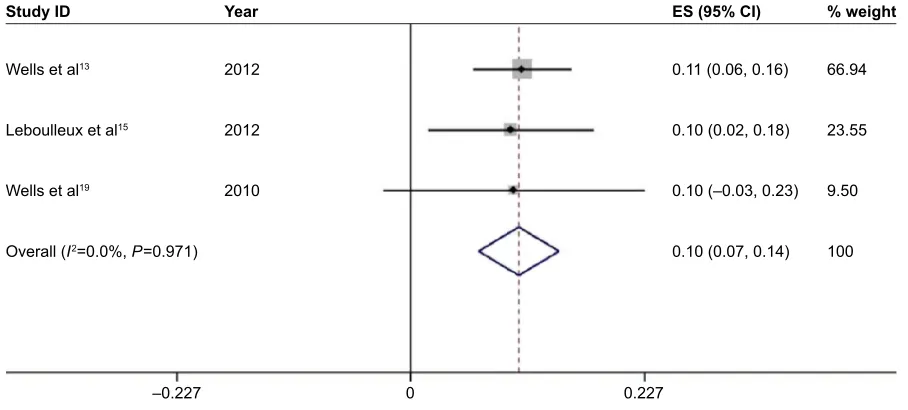OncoTargets and Therapy 2016:9 3621–3631
OncoTargets and Therapy
Dove
press
submit your manuscript | www.dovepress.com 3621
O r i g i n a l r e s e a r c h
open access to scientific and medical research
Open access Full Text article
a systematic review and meta-analysis of the risk
of diarrhea associated with vandetanib treatment
in carcinoma patients
Zijun huo* shuang Yu* shubin hong Xiaopei cao lingling Xiu Zhihong liao Yanbing li haipeng Xiao
Department of endocrinology, The First affiliated hospital of sun Yat-sen University, guangzhou, guangdong, People’s republic of china
*These authors contributed equally to this work
Background and purpose: Vandetanib is a promising anticancer targeted agent for treating advanced carcinomas, such as non-small-cell lung cancer, small-cell lung cancer, breast cancer, malignant glioma, hepatocellular cancer, and unresectable, locally advanced, or metastatic medullary thyroid cancer. However, diarrhea is a frequently reported adverse event. The inci-dence of vandetanib-associated diarrhea varies extensively in different study populations and has not been carefully estimated. This systematic review and meta-analysis of clinical trials aims to figure out the overall risks of all-grade and high-grade diarrhea during vandetanib treatment and get a better understanding of its prediction and management.
Materials and methods: A comprehensive search was performed in EMBASE, PubMed, and Cochrane Library for clinical trials studying vandetanib and diarrhea prior to April 2015. Eligible articles were selected according to the inclusion criteria. Data were extracted to calculate the summary incidence of all-grade and high-grade diarrhea caused by vandetanib treatment.
Results: Thirteen clinical trials that involved 3,264 patients were included in this meta-analysis. The overall incidences of all-grade and high-grade diarrhea caused by vandetanib treatment were 52.1% (95% confidence interval [CI], 48.3%–55.8%) and 5.6% (95% CI, 4.4%–76.7%), respectively. The risk ratios of the all-grade and high-grade diarrhea for vandetanib arm versus control arm were 1.932 (95% CI, 1.746–2.138; P,0.001) and 3.190 (95% CI, 2.061–4.938;
P,0.001), respectively. Studies with small-cell lung cancer demonstrated the highest incidence of all-grade diarrhea (78.85%) and high-grade diarrhea (17.31%), whereas the lowest incidences of all-grade (42.11%) and high-grade (2.67%) diarrhea are seen in patients with hepatocellular carcinoma and non-small-cell lung cancer, respectively.
Conclusion: Our findings demonstrate that the administration of vandetanib leads to a signifi-cantly increased risk of diarrhea, which varies in different carcinoma patients. Early recognition and timely management may be key factors to avoid dose reduction, drug interruption, and drug discontinuation, which is significant to maximize the treatment benefits.
Keywords: vandetanib treatment, diarrhea, carcinoma
Introduction
Malignant tumor is the leading cause of death worldwide. Most cancer patients who are diagnosed at advanced stage are not candidates for surgical curative resection and are only amenable to palliative treatment. Traditional chemotherapy is a main treatment. However, the tumor response to traditional chemotherapy is not usually satisfactory. Nowadays, a large number of clinical studies have demonstrated that a newly developing therapy, molecular-targeted therapy, exerts a positive influence on advanced tumors, which shows considerable promise.
correspondence: haipeng Xiao Department of endocrinology, The First Affiliated Hospital of Sun Yat-sen University, no 58 Zhongshan 2nd road, guangzhou 510080, guangdong, People’s republic of china Tel +86 20 8775 5766 ext 8803 Fax +86 20 8733 0736 email xiaohp@mail.sysu.edu.cn
Journal name: OncoTargets and Therapy Article Designation: Original Research Year: 2016
Volume: 9
Running head verso: Huo et al
Running head recto: Risk of diarrhea of vandetanib treatment DOI: http://dx.doi.org/10.2147/OTT.S96830
OncoTargets and Therapy downloaded from https://www.dovepress.com/ by 118.70.13.36 on 25-Aug-2020
For personal use only.
Number of times this article has been viewed
This article was published in the following Dove Press journal: OncoTargets and Therapy
Dovepress
huo et al
Vandetanib (ZD6474, Caprelsa; AstraZeneca plc, London, UK) is a once-daily oral anticancer agent that selectively targets the vascular endothelial growth factor receptor (VEGFR)-2 and -3, epidermal growth factor receptor (EGFR), and rear-ranged during transfection.1,2 The activity of competing the ATP binding sites of these receptors makes vandetanib a good agent inhibiting tumor cell proliferation, tumor progression, and angiogenesis.3
The mechanism and effect of vanditanib have been searched out by many prior studies. To our knowledge, VEGFR and EGFR are well-known pivotal drivers in tumor carcinogenesis, which actively contribute to the pathogen-esis and progression of many different kinds of cancers. Furthermore, the VEGFR and EGFR pathways are shown to be relevant. Since EGFR regulates the production of VEGF, resistance of EGFR inhibitors, such as erlotinib and gefitinib, is thought to be associated with the increase of VEGF, which means targeting both VEGFR and EGFR simultaneously may be more effective than using the inhibitors of either pathway.4 EGFR and VEGFR are clinical validated targets in non-small-cell lung cancer (NSCLC), small-cell lung cancer (SCLC), thyroid cancer, breast cancer, malignant glioma, and hepatocellular cancer, which are common worldwide malignant tumors threatening people’s health. As an inhibi-tor of both VEGFR and EGFR, vandetanib has been shown to have clinically meaningful benefits in these cancers in previous clinical trials.
Besides, vandetanib has been reported to have the inhibiting effect on rearranged during transfection. And the gain-of-function mutation in the rearranged during transfec-tion protooncogenes is the key driver in the development of hereditary medullary thyroid cancer (MTC).5,6 Therefore, it is well demonstrated that vandetanib shows a particularly powerful efficacy in the treatment of MTC7 and is currently approved for use in clinical practice. In April 2011, the US Food and Drug Administration approved it for the treatment of unresectable, locally advanced, or metastatic MTC.8 According to several Phase I trials, the daily tolerable dose of vandetanib is 300 mg or less, with the regimen of giving once daily.
However, several adverse events are commonly reported during the application of vandetanib, including diarrhea, rash,9 nausea, hypertension,10 headache, and corrected QT interval prolongation.8 Among these adverse events, diar-rhea and other gastrointestinal diseases are most frequently detected, which is consistent to the activity of inhibiting EGFR by vandetanib. Similar to other tyrosine kinase inhibitor of the VEGFR and EGFR, patients receiving
vandetanib treatment experience higher incidence of diarrhea than patients receiving placebo only. In several clinical trials, the diarrhea is so severe that it leads to dose reduction, interruption, or drug discontinuation, and causes a lower quality of life. So far, the total incidence of diarrhea in patients receiving vandetanib treatment is still unclear. According to the previous clinical trials, the incidences of all-grade and high-grade diarrhea vary enormously from 42.11% to 78.85% and from 2.67% to 17.31%, respectively, which is probably due to the various sample sizes, tumor types, or patient sources.
The aim of this paper is to figure out the overall risks of all-grade and high-grade diarrhea during vandetanib treat-ment and get a better understanding of its prediction and management.
Materials and methods
literature sources
A literature search was performed in the databases, including EMBASE, PubMed, and Cochrane Library, using the search-ing terms “vandetanib” and “diarrhea”. The related articles function was used to extend the search. The last search date was April 25, 2015. Two authors independently screened the titles and abstracts to determine potential eligibility for this meta-analysis. When discrepancies occurred, consensus was achieved after further discussion.
inclusion and exclusion criteria and data
extraction
All available randomized controlled trials and observational comparative studies that compared vandetanib with placebo or other tyrosine kinase inhibitor were included. The language was restricted to English. Editorials comments, letters to editor, review studies, case reports, conference abstracts, and experimental animal studies were excluded. Since traditional chemotherapy may increase the risk of diarrhea, studies that combined vandetanib with other traditional chemotherapy in the treatment arm were excluded. Besides, because of the different dose levels, Phase I trials were also excluded. To conclude, the inclusion criteria include 1) application of vandetanib 300 mg/d as a single agent in the treatment arm; 2) prospective Phase II and III clinical trials conducted in patients with cancers; and 3) full texts and data of diarrhea available. Two authors independently extracted the following data from the selected articles: first authors, year of publica-tion, trial design, number of patients in the vandetanib arm, number of patients in the control arm, underlying cancer, and number of patients suffering all-grade or high-grade
OncoTargets and Therapy downloaded from https://www.dovepress.com/ by 118.70.13.36 on 25-Aug-2020
Dovepress risk of diarrhea of vandetanib treatment
diarrhea. We contacted the authors of the original articles for further clarification if relevant information was unclear. In order to accurately select articles that met the inclusion criteria, two authors independently did the searching work and evaluated each article.
Outcome measure
The primary outcome of this meta-analysis was the total incidence of all-grade and high-grade diarrhea in patients receiving vandetanib treatment. Subgroup analysis was conducted by distinguishing among the patients of different tumor types. The secondary outcome of this meta-analysis was the comparison of the incidence of all-grade and high-grade diarrhea between patients in the vandetanib group and the control group.
Diarrheas were classified according to the National Cancer Institute (Bethesda MD, USA) Common Toxicity Criteria Ver-sion 2 or Common Terminology Criteria for Adverse Events Version 3 (Table 1).11
statistical analysis
This meta-analysis was performed using Version 12 of the Stata program (StataCorp LP. College Station, TX, USA). The proportions of patients with all-grade and high-grade diarrheas for each clinical trial were calculated, and the 95% confidence interval (CI) was derived. For studies that performed a comparison between the vandetanib group and control group, the relative risks of all-grade and high-grade diarrheas among patients in the vandetanib group were also calculated. Two-side hypothesis was used with a =0.5. Statistically significant difference was set at a P-value #0.05. The heterogeneity of each study was evaluated by a visual inspection of forest plots and an inconsistency (I2) statistic.
I2 values .50% or P-value ,0.05 indicated heterogeneity. When the heterogeneity exists, random-effects model was applied. Otherwise, the fixed-effects model was considered.
Results
Overview of searching results
A total of 59 reports on clinical use of vandetanib were yielded by the comprehensive search, of which 35 articles were selected based on their titles, abstracts, and article types. After the full publication review of 29 potentially eligible articles, the 13 studies that fulfilled the inclusion criteria were finally selected and analyzed (Figure 1).12–24
characteristics of included studies
The characteristics of the studies included in the meta-analysis are presented in Table 2. A total of 3,264 patients (1,964 in the vandetanib arm and 1,300 in the control arm) from 13 studies were included. Among the 13 studies, three were randomized-controlled Phase III studies,13,16,18 seven were randomized-controlled Phase II studies,12,15,17,18,20–22 one was nonrandomized-controlled Phase II study,24 and the remaining two were single arm Phase II studies.14,19
Comparisons between patients receiving vandetanib and placebo were performed in six clinical trials,12,13,15–17,23 while five trials were just included for the analysis of the use of vandetanib.14,19,21,22,24 The remaining two trials compared the use of vandetanib, erlotinib,18 and gefitinib,20 respectively.
Two studies included patients having 100 or 300 mg/d in the vandetanib arm.17,24 But, as is mentioned in the inclusion criteria, only data about the dose of 300 mg/d were extracted in this meta-analysis. One study included patients having vandetanib only, vandetanib combined with PC (P, paclitaxel 200 mg/m2; C, carboplatin 6 mg/mL*min), and placebo with PC.22 Since PC belongs to traditional chemotherapy agents, only data of the vandetanib arm were applied in the analysis.
In these 13 included trials, the associated underlying malignant neoplasms were NSCLC (six trials12,16,18,20–22), thyroid carcinoma (three trials13,15,19), malignant glioma (one trial14), hepatocellular carcinoma (one trial17), SCLC (one trial23), and metastatic breast cancer (one trial24).
Primary outcomes
The total incidences of all-grade and high-grade diarrhea
For the incidence analysis, we considered only arms receiving vandetanib 300 mg as a single agent. All-grade diarrhea was reported in all the 13 studies, with 1,964 patients treated by 300 mg vandetanib, and its incidence ranged from 42.11% in a randomized-controlled Phase II study of patients of hepatocellular carcinoma17 to 78.85% in another randomized-controlled Phase II study of patients of SCLC.23 Since the meta-analysis revealed no evidence of heterogeneity of the Table 1 Us national cancer institute grading for diarrhea
grade 1 increase of fewer than four stools per day over baseline grade 2 increase of four to six stools per day over baseline,
intravenous fluids ,24 hours
grade 3 increase of seven or more stools per day over baseline incontinence
Intravenous fluids $24 hours hospitalization indicated
limits self-care activities of daily living grade 4 life-threatening consequences
Urgent intervention indicated
grade 5 Death
OncoTargets and Therapy downloaded from https://www.dovepress.com/ by 118.70.13.36 on 25-Aug-2020
Dovepress
huo et al
included studies (heterogeneity test, I2=18.7%, P=0.255), the fixed-effects model was applied. The calculated summary incidence of all-grade diarrhea was calculated to be 52.1% (95% CI, 48.3%–55.8%) (Figure 2).
High-grade diarrhea was associated with serious mor-bidity and prone to dose reduction, drug interruption, and drug discontinuation. Among the 13 studies, only eleven had available data for high-grade diarrhea, which include 1,881 patients treated by 300 mg vandetanib. The incidence of high-grade diarrhea varied remarkably from 2.67% to 17.31%, with the lowest incidence observed in a randomized-controlled Phase II study of patients of NSCLC,12 and the highest incidence noted in a randomized-controlled Phase II study of patients of SCLC.23 Using the fixed-effects model (heterogeneity test, I2=35.8%, P=0.113), the meta-analysis revealed that the overall incidence of high-grade diarrhea was 5.6% (95% CI, 4.4%–6.7%) (Figure 3).
incidences of all-grade and high-grade diarrhea of different tumor types
We further calculated the incidences of all-grade and high-grade diarrhea based on different tumor types to explore the relationship between diarrhea and tumor types. For a total of 1,472 patients receiving vandetanib with NSCLC, the pooled incidence of all-grade and high-grade diar-rhea was 49.6% (95% CI, 45.3%–53.8%) (Figure S1) and 4.9% (95% CI, 3.7%–6.2%) (Figure S2), respectively. For studies associated with thyroid carcinoma, 333 patients in total were involved to receive vandetanib treatment, yielding a total incidence of all-grade diarrhea of 61.0% (95% CI, 51.2%–70.7%) (Figure S3), and an incidence of high-grade diarrhea of 10.5% (95% CI, 6.6%–14.4%) (Figure S4). Only one trial was conducted in other types of tumor, respectively. And the two trials associated with malignant glioma and hepatocellular carcinoma only had
6FUHHQLQJ
,QFOXGHG
(OLJLELOLW\
,GHQWLILFDWLRQ
5HFRUGVLGHQWLILHGWKURXJK
GDWDEDVHVHDUFKLQJQ WKURXJKRWKHUVRXUFHVQ $GGLWLRQDOUHFRUGVLGHQWLILHG
5HFRUGVDIWHUGXSOLFDWHVUHPRYHGQ
6WXGLHVLQFOXGHGEDVHGRQ WKHLQFOXVLRQFULWHULD
Q
6WXGLHVLQFOXGHGLQ TXDQWLWDWLYHV\QWKHVLV PHWDDQDO\VLVQ
5HFRUGVH[FOXGHGGXHWRWKH IDLOXUHRIJHWWLQJWKHIXOOWH[WDUWLFOHV
Q
5HFRUGVH[FOXGHGEDVHGRQWKHLU WLWOHVDEVWUDFWVRUDUWLFOHW\SHV
Q 5HFRUGVVFUHHQHGQ
)XOOWH[WDUWLFOHVDVVHVVHG IRUHOLJLELOLW\Q
Figure 1 Identification of included studies in this systematic review and meta-analysis.
OncoTargets and Therapy downloaded from https://www.dovepress.com/ by 118.70.13.36 on 25-Aug-2020
Dovepress risk of diarrhea of vandetanib treatment
Table 2 characteristics of studies included in the meta-analysis
First author Year Trial design Vandetanib arm Control arm Population of vandetanib arm
Population of control arm
Underlying cancer
ahn et al12 2013 randomized
Phase ii study
Vandetanib 300 mg Placebo 75 42 advanced
or metastatic nsclc Wells et al13 2012 randomized
Phase iii study
Vandetanib 300 mg Placebo 231 100 Medullary
thyroid cancer Kreisl et al14 2012 single arm
Phase ii study
Vandetanib 300 mg 64 recurrent
malignant glioma leboulleux et al15 2012 randomized
Phase ii study
Vandetanib 300 mg Placebo 72 73 Differentiated
thyroid cancer lee et al16 2012 randomized
Phase iii study
Vandetanib 300 mg Placebo 617 307 advanced nsclc
hsu et al17 2012 randomized
Phase ii study
Vandetanib 300 mg Placebo 19 23 inoperable hcc
natale et al18 2011 randomized
Phase iii study
Vandetanib 300 mg erlotinib 150 mg 623 617 advanced nsclc
Wells et al19 2010 single arm
Phase ii study
Vandetanib 300 mg 30 Medullary
thyroid cancer natale et al20 2009 randomized
Phase ii study
Vandetanib 300 mg Gefitinib 250 mg 83 85 advanced nsclc
heymach et al22 2008 randomized
Phase ii study
Vandetanib 300 mg 56 nsclc
Kiura et al21 2008 randomized
Phase ii study
Vandetanib 300 mg 18 nsclc
arnold et al23 2007 randomized,
Phase ii study
Vandetanib 300 mg Placebo 52 53 sclc
Miller et al24 2005 nonrandomized
Phase ii study
Vandetanib 300 mg 24 Metastatic
breast cancer Abbreviations: hcc, hepatocellular carcinoma; nsclc, non-small-cell lung carcinoma; sclc, small-cell lung carcinoma.
6WXG\,' <HDU
$KQHWDO
:HOOVHWDO
.UHLVOHWDO
/HERXOOHX[HWDO
/HHHWDO
+VXHWDO
1DWDOHHWDO
:HOOVHWDO
1DWDOHHWDO
+H\PDFKHWDO
.LXUDHWDO
$UQROGHWDO
0LOOHUHWDO
2YHUDOO, 3
(6&,
±
ZHLJKW
Figure 2 Forest plot of the total incidence of all-grade diarrhea of patients with carcinomas receiving vandetanib.
Notes: The size of the gray square corresponded to the weight of the study in the meta-analysis. The horizontal line represented the 95% confidence interval (CI), and the vertical dotted line showed the total incidence of all-grade diarrhea. since heterogeneity test indicated no heterogeneity, the total incidence of all-grade diarrhea was calculated using the fixed-effects model.
Abbreviation: es, effect size.
OncoTargets and Therapy downloaded from https://www.dovepress.com/ by 118.70.13.36 on 25-Aug-2020
Dovepress
huo et al
available data for all-grade diarrhea. According to the provided data, the overall incidences of all-grade diarrhea of malignant glioma, hepatocellular carcinoma, SCLC, and metastatic breast cancer were 53% (95% CI, 32%–74%), 42% (95% CI, 7%–77%), 79% (95% CI, 52%–105%), and 67% (95% CI, 29%–104%), respectively, while high-grade diarrhea was seen in 17% (95% CI, 4%–30%) and 12% (95% CI, −4%–29%) in trials associated with SCLC and metastatic breast cancer, respectively.
secondary outcomes
risk ratios of all-grade and high-grade diarrhea
There are eight comparative clinical trials in total, which include six trials using placebo as controls, one using erlotinib, and one using gefitinib. Subjects in the vandetanib arm were at a significantly higher risk for all-grade diarrhea than subjects in the control arm (relative risk =1.932; 95% CI, 1.746–2.138; P,0.001) (Figure 4), with the use of the random-effects model (heterogeneity test, I2=90.9%, $KQHWDO
:HOOVHWDO /HERXOOHX[HWDO /HHHWDO 1DWDOHHWDO :HOOVHWDO 1DWDOHHWDO +H\PDFKHWDO .LXUDHWDO $UQROGHWDO 0LOOHUHWDO
2YHUDOO, 3
±
6WXG\,' <HDU
±
±
± ± (6&,
ZHLJKW
Figure 3 Forest plot of the total incidence of high-grade diarrhea of patients with carcinomas receiving vandetanib.
Notes: The size of the gray square corresponded to the weight of the study in the meta-analysis. The horizontal line represented the 95% confidence interval (CI) and the vertical dotted line showed the total incidence of high-grade diarrhea. since heterogeneity test indicated no heterogeneity, the total incidence of high-grade diarrhea was calculated using the fixed-effects model.
Abbreviation: es, effect size.
$KQHWDO
:HOOVHWDO
/HERXOOHX[HWDO
/HHHWDO
+VXHWDO
1DWDOHHWDO
1DWDOHHWDO
$UQROGHWDO
2YHUDOO, 3
6WXG\,' <HDU
55&,
ZHLJKW
Figure 4 Forest plot of the relative risk (RR) of all-grade diarrhea events.
Notes: The size of the gray square corresponded to the weight of the study in the meta-analysis. The horizontal line represented the 95% confidence interval (CI) and the vertical dotted line showed the total rr of all-grade diarrhea.
OncoTargets and Therapy downloaded from https://www.dovepress.com/ by 118.70.13.36 on 25-Aug-2020
Dovepress risk of diarrhea of vandetanib treatment
P,0.001). Seven out of these eight clinical trials provide data of high-grade diarrhea. Subjects in the vandetanib group were at a notably greater risk for high-grade diarrhea than subjects in the control arm (relative risk =3.190; 95% CI, 2.061–4.938,
P,0.001) (Figure 5), with the application of the random-effects model (heterogeneity test, I2=59.5%, P=0.022).
Discussion
Vandetanib is a promising anticancer targeted agent in NSCLC, SCLC, thyroid cancer, breast cancer, malignant glioma, and hepatocellular carcinoma. And it is the first oral medicine with demonstrated antineoplastic role in MTC, which has been approved by the US Food and Drug Administration for the treatment of unresectable, locally advanced, or metastatic MTC. To our knowledge, diarrhea is one of the most common adverse events when patients receive vandetanib treatment. However, the understand-ing of diarrhea caused by vandetanib is still limited. Our meta-analysis summarized all the clinical trials regarding vandetanib-associated diarrhea in carcinoma patients. Based on the available data, our results revealed that vandetanib caused a significantly increased risk of diarrhea. The overall incidences of all-grade and high-grade diarrhea are 52.1% and 5.6%, respectively.
In fact, many studies demonstrated that diarrhea was the most common reported adverse event of treatment with tar-geted agents in carcinoma patients.25 Though the mechanism remained poorly understood, diarrhea caused by vandetanib
treatment is most likely attributed to its anti-EGFR activity. EGFR is frequently expressed on normal epithelium-originated cells, such as skin, gastrointestinal mucosa, and liver. It plays a crucial role in cells proliferation and growth. This may explain why diarrhea, rash, and oral mucositis are frequently observed in patients treated with EGFR inhibitors. As is mentioned in the study of Uribe et al,26 EGF inhibits the Ca
2+-dependent Cl− secretion in T84 human colonic epithelial cells. In other words, anti-EGFR agents counteract this effect and thus lead to excessive secretion of Cl– in the gastrointestinal tract, which secondarily causes diarrhea. This is believed to be the most probable etiology of diarrhea caused by vandetanib treatment. Besides, some studies indicated that multiple factors might contribute to the EGFR inhibitor-associated diarrhea, such as quickened intestinal peristalsis, alteration of intestinal micro flora,27 and colonic crypt impairment, which resulted in decreased absorption of water.
Considering that different tumor types may result in different incidences of diarrhea, we analyzed the incidences based on different tumor types. As is shown in the results, patients with SCLC treated with vandetanib demonstrated the highest incidence of all-grade diarrhea (78.85%) and high-grade diarrhea (17.31%), whereas the lowest incidences of all-grade (42.11%) and high-grade diarrhea (2.67%) were seen in patients with hepatocellular carcinoma and NSCLC, respectively. Compared with other meta-analyses, the incidence of diarrhea caused by vandetanib is similar to that of other anti-EGFR agents.
6WXG\,' <HDU
$KQHWDO
:HOOVHWDO
/HERXOOHX[HWDO
/HHHWDO
1DWDOHHWDO
1DWDOHHWDO
$UQROGHWDO
2YHUDOO, 3
55&,
ZHLJKW
Figure 5 Forest plot of the relative risk (RR) of high-grade diarrhea events.
Notes: The size of the gray square corresponded to the weight of the study in the meta-analysis. The horizontal line represented the 95% confidence interval (CI) and the vertical dotted line showed the total rr of high-grade diarrhea.
OncoTargets and Therapy downloaded from https://www.dovepress.com/ by 118.70.13.36 on 25-Aug-2020
Dovepress
huo et al
Because of the potential for long-term application of vandetanib in patients with cancers, it is important for doc-tors and patients to have a good understanding of the severity of diarrhea. Diarrhea is impactful on a patient’s quality of life, and may lead to water and electrolyte imbalance, renal insufficiency, corrected QT interval prolongation, or other severe consequences. It should be carefully evaluated and early intervention should be taken. Essentially, meticulous pretreatment education is of great importance. Patients should be informed what diarrhea is, the incidence and the severity of the high-grade diarrhea, when to contact the health care team, and how to manage diarrhea if it is not so severe. Once diarrhea occurs, it can be treated at home first. Patients should be instructed to drink enough water to avoid dehydration. At the same time, antidiarrhea agents should be applied at the onset of diarrhea. Loperamide still has a prominent role in the treatment of EGFR inhibitor-associated diarrhea. It is recommended to begin at a dose of 4 mg at the onset, and then 2 mg every four hours until the diarrhea ceases.28 Moreover, loperamide is not recommended to use over 20 mg every day in adults. Besides, diphenoxylate/ atropine and codeine can also be considered to control the diarrhea. If diarrhea gets worse after 48 hours, hospitaliza-tion is needed. Doctors should perform a careful physical examination and assess the dehydration severity.29 Close attention should be paid to electrolyte and electrocardiogram results. Through the above managements, early identifica-tion and timely management can be reached to help prevent aggravation, dose reduction, and vandetanib interruption, which is helpful to achieve the maximum benefits from the treatment.30
However, if grade 2 diarrhea continues for .2 days, or grade 3/4 diarrhea occurs, vandetanib treatment must be interrupted or the dose must be reduced. Meanwhile, the antidiarrhea agents should still be put into use. If severe diarrhea persists .2 weeks, vandetanib treatment should be permanently discontinued until diarrhea ceases and resumed at a lower dose. If still the diarrhea continues after the cessa-tion of vandetanib, fecal and bloody laboratory examinacessa-tions for pathogens are strongly suggested.
As in previous studies, rash resulting from EGFR tyrosine kinase inhibitor was a probable predictor of benefit and the severity of rash correlated with clinical benefit. The development of diarrhea caused by vandetanib may also be linked to better clinical responses. It has been suggested that diarrhea may serve as a positive prognostic indicator in several previous studies. Early in the study of Cohen et al,31 diarrhea was found to have a clear rela-tionship with more favorable overall survival in patients
with recurrent and metastatic squamous cell carcinoma of the head and neck who underwent erlotinib, lapatinib, or gefitinib treatment. Later in the studies of Zheng et al,32 Zhang et al,33 and Bettinger et al,34 it has been proved that diarrhea caused by sorafenib was a positive independent predictor of better progression-free survival and overall survival in patients with metastatic renal cell carcinoma or advanced hepatocellular carcinoma. Until now, no study has shown the association between diarrhea caused by vandetanib and clinical responses. Therefore, a further prospective experiment is needed. If the diarrhea caused by vandetanib really predicts a positive result, clinical doctors could have a better command of the outcome of disease.
Limitations
There are several limitations in our study. First, the included studies are heterogeneous in tumor types, which may influence the pooled estimates of the total incidence of diarrhea. Second, there are potential biases from preferential publication and selective reporting. Third, no data in our study imply the relationship of diarrhea severity and clinical responses. Finally, no risk factors could be found in the included studies, so we cannot predict which kind of patients should be closely taken care of.
Conclusion
Our study provides evidences that vandetanib treatment leads to a significantly increased incidence of diarrhea. However, whether the increased severity is associated with a preferable clinical response is still unclear. Further exploration is needed to examine the underlying association. Early recognition and management of diarrhea should be emphasized since it might be a vital factor for the success of the anticarcinoma treatment.
Disclosure
The authors report no conflicts of interest in this work.
References
1. Carlomagno F, Vitagliano D, Guida T, et al. ZD6474, an orally available inhibitor of KDR tyrosine kinase activity, efficiently blocks oncogenic RET kinases. Cancer Res. 2002;62:7284–7290.
2. Wedge SR, Ogilvie DJ, Dukes M, et al. ZD6474 inhibits vascular endothelial growth factor signaling, angiogenesis, and tumor growth following oral administration. Cancer Res. 2002;62:4645–4655. 3. Morabito A, Piccirillo MC, Costanzo R, et al. Vandetanib: An overview
of its clinical development in NSCLC and other tumors. Drugs Today
(Barc). 2010;46:683–698.
4. Naumov GN, Nilsson MB, Cascone T, et al. Combined vascular endothe-lial growth factor receptor and epidermal growth factor receptor (EGFR) blockade inhibits tumor growth in xenograft models of EGFR inhibitor resistance. Clin Cancer Res. 2009;15:3484–3494.
OncoTargets and Therapy downloaded from https://www.dovepress.com/ by 118.70.13.36 on 25-Aug-2020
Dovepress risk of diarrhea of vandetanib treatment
5. Morabito A, Piccirillo MC, Falasconi F, et al. Vandetanib (ZD6474), a dual inhibitor of vascular endothelial growth factor receptor (VEGFR) and epidermal growth factor receptor (EGFR) tyrosine kinases: current status and future directions. Oncologist. 2009;14:378–390.
6. Lodish MB, Stratakis CA. RET oncogene in MEN2, MEN2B, MTC and other forms of thyroid cancer. Expert Rev Anticancer Ther. 2008;8: 625–632.
7. Sim MW, Cohen MS. The discovery and development of vandetanib for the treatment of thyroid cancer. Expert Opin Drug Discov. 2014;9: 105–114.
8. Grabowski P, Briest F, Baum RP, et al. Vandetanib therapy in medullary thyroid cancer. Drugs Today (Barc). 2012;48:723–733.
9. Rosen AC, Wu S, Damse A, Sherman E, Lacouture ME. Risk of rash in cancer patients treated with vandetanib: systematic review and meta-analysis. J Clin Endocrinol Metab. 2012;97:1125–1133.
10. Qi WX, Shen Z, Lin F, et al. Incidence and risk of hypertension with vandetanib in cancer patients: a systematic review and meta-analysis of clinical trials. Br J Clin Pharmacol. 2013;75:919–930.
11. Yang JC, Reguart N, Barinoff J, et al. Diarrhea associated with afatinib: an oral ErbB family blocker. Expert Rev Anticancer Ther. 2013;13: 729–736.
12. Ahn JS, Lee KH, Sun JM, et al. A randomized, phase II study of vande-tanib maintenance for advanced or metastatic non-small-cell lung cancer following first-line platinum-doublet chemotherapy. Lung Cancer. 2013;82:455–460.
13. Wells SA Jr, Robinson BG, Gagel RF, et al. Vandetanib in patients with locally advanced or metastatic medullary thyroid cancer: a randomized, double-blind phase III trial. J Clin Oncol. 2012;30:134–141. 14. Kreisl TN, McNeill KA, Sul J, Iwamoto FM, Shih J, Fine HA. A phase
I/II trial of vandetanib for patients with recurrent malignant glioma.
Neuro Oncol. 2012;14:1519–1526.
15. Leboulleux S, Bastholt L, Krause T, et al. Vandetanib in locally advanced or metastatic differentiated thyroid cancer: a randomised, double-blind, phase 2 trial. Lancet Oncol. 2012;13:897–905. 16. Lee JS, Hirsh V, Park K, et al. Vandetanib Versus placebo in patients
with advanced non-small-cell lung cancer after prior therapy with an epidermal growth factor receptor tyrosine kinase inhibitor: a random-ized, double-blind phase III trial (ZEPHYR). J Clin Oncol. 2012;30: 1114–1121.
17. Hsu C, Yang TS, Huo TI, et al. Vandetanib in patients with inoper-able hepatocellular carcinoma: a phase II, randomized, double-blind, placebo-controlled study. J Hepatol. 2012;56:1097–1103.
18. Natale RB, Thongprasert S, Greco FA, et al. Phase III trial of vandetanib compared with erlotinib in patients with previously treated advanced non-small-cell lung cancer. J Clin Oncol. 2011;29:1059–1066. 19. Wells SA Jr, Gosnell JE, Gagel RF, et al. Vandetanib for the treatment
of patients with locally advanced or metastatic hereditary medullary thyroid cancer. J Clin Oncol. 2010;28:767–772.
20. Natale RB, Bodkin D, Govindan R, et al. Vandetanib versus gefitinib in patients with advanced non-small-cell lung cancer: results from a two-part, double-blind, randomized phase ii study. J Clin Oncol. 2009;27: 2523–2529.
21. Kiura K, Nakagawa K, Shinkai T, et al. A randomized, double-blind, phase II a dose-finding study of Vandetanib (ZD6474) in Japanese patients with non-small cell lung cancer. J Thorac Oncol. 2008;3: 386–393.
22. Heymach JV, Paz-Ares L, De Braud F, et al. Randomized phase II study of vandetanib alone or with paclitaxel and carboplatin as first-line treat-ment for advanced non-small-cell lung cancer. J Clin Oncol. 2008;26: 5407–5415.
23. Arnold AM, Seymour L, Smylie M, et al; National Cancer Institute of Canada Clinical Trials Group Study BR.20. Phase II study of vandetanib or placebo in small-cell lung cancer patients after complete or partial response to induction chemotherapy with or without radiation therapy: National Cancer Institute of Canada Clinical Trials Group Study BR.20.
J Clin Oncol. 2007;25:4278–4284.
24. Miller KD, Trigo JM, Wheeler C, et al. A multicenter phase II trial of ZD6474, a vascular endothelial growth factor receptor-2 and epider-mal growth factor receptor tyrosine kinase inhibitor, in patients with previously treated metastatic breast cancer. Clin Cancer Res. 2005; 11:3369–3376.
25. Elting LS, Chang YC, Parelkar P, et al; Mucositis Study Group of the Multinational Association of Supportive Care in Cancer/International Society of Oral Oncology (MASCC/ISOO). Risk of oral and gastro-intestinal mucosal injury among patients receiving selected targeted agents: a meta-analysis. Support Care Cancer. 2013;21:3243–3254. 26. Uribe JM, Gelbmann CM, Traynor-Kaplan AE, Barrett KE. Epidermal
growth factor inhibits Ca(2+)-dependent Cl- transport in T84 human
colonic epithelial cells. Am J Physiol. 1996; 271:C914–C922. 27. Al-Dasooqi N, Gibson R, Bowen J, Keefe D. HER2 targeted therapies
for cancer and the gastrointestinal tract. Curr Drug Targets. 2009;10: 537–542.
28. Hirsh V, Blais N, Burkes R, Verma S, Croitoru K. Management of diarrhea induced by epidermal growth factor receptor tyrosine kinase inhibitors. Curr Oncol. 2014;21:329–336.
29. Grande E, Kreissl MC, Filetti S, et al. Vandetanib in advanced medullary thyroid cancer: review of adverse event management strategies.
Adv Ther. 2013;30:945–966.
30. Hirsh V. Managing treatment-related adverse events associated with egfr tyrosine kinase inhibitors in advanced non-small-cell lung cancer.
Curr Oncol. 2011;18:126–138.
31. Cohen EE, Halpern AB, Kasza K, Kocherginsky M, Williams R, Vokes EE. Factors associated with clinical benefit from epidermal growth factor receptor inhibitors in recurrent and metastatic squamous cell carcinoma of the head and neck. Oral Oncol. 2009;45:e155–e160. 32. Zheng Y, Wang F, Wu G, et al. The relationship between the adverse
events and efficacy of sorafenib in patients with metastatic renal cell carcinoma: a multicenter retrospective study from Northwest China.
Medicine (Baltimore). 2015;94:e2222.
33. Zhang HL, Qin XJ, Wang HK, et al. Clinicopathological and prognostic factors for long-term survival in Chinese patients with metastatic renal cell carcinoma treated with sorafenib: a single-center retrospective study. Oncotarget. 2015;6:36870–36883.
34. Bettinger D, Schultheiss M, Knuppel E, Thimme R, Blum HE, Spangenberg HC. Diarrhea predicts a positive response to sorafenib in patients with advanced hepatocellular carcinoma. Hepatology. 2012;56: 789–790.
OncoTargets and Therapy downloaded from https://www.dovepress.com/ by 118.70.13.36 on 25-Aug-2020
Dovepress
huo et al
Supplementary materials
$KQHWDO
/HHHWDO
+H\PDFKHWDO
.LXUDHWDO 1DWDOHHWDO
1DWDOHHWDO
2YHUDOO, 3
±
6WXG\,' <HDU
(6&,
ZHLJKW
Figure S1 Forest plot of the total incidence of all-grade diarrhea of patients with non-small-cell lung cancer receiving vandetanib.
Notes: The size of the gray square corresponded to the weight of the study in the meta-analysis. The horizontal line represented the 95% confidence interval (CI) and the vertical dotted line showed the total incidence of all-grade diarrhea. since heterogeneity test indicated no heterogeneity, the total incidence of all-grade diarrhea was calculated using the fixed-effects model.
Abbreviation: es, effect size.
6WXG\,' <HDU (6&,
±
±
ZHLJKW
$KQHWDO
+H\PDFKHWDO
.LXUDHWDO
2YHUDOO, 3
/HHHWDO
1DWDOHHWDO
1DWDOHHWDO
±
Figure S2 Forest plot of the total incidence of high-grade diarrhea of patients with non-small-cell lung cancer receiving vandetanib.
Notes: The size of the gray square corresponded to the weight of the study in the meta-analysis. The horizontal line represented the 95% confidence interval (CI) and the vertical dotted line showed the total incidence of high-grade diarrhea. since heterogeneity test indicated no heterogeneity, the total incidence of high-grade diarrhea was calculated using the fixed-effects model.
Abbreviation: es, effect size.
OncoTargets and Therapy downloaded from https://www.dovepress.com/ by 118.70.13.36 on 25-Aug-2020
OncoTargets and Therapy
Publish your work in this journal
Submit your manuscript here: http://www.dovepress.com/oncotargets-and-therapy-journal
OncoTargets and Therapy is an international, peer-reviewed, open access journal focusing on the pathological basis of all cancers, potential targets for therapy and treatment protocols employed to improve the management of cancer patients. The journal also focuses on the impact of management programs and new therapeutic agents and protocols on
patient perspectives such as quality of life, adherence and satisfaction. The manuscript management system is completely online and includes a very quick and fair peer-review system, which is all easy to use. Visit http://www.dovepress.com/testimonials.php to read real quotes from published authors.
Dovepress
Dove
press
risk of diarrhea of vandetanib treatment
6WXG\,' <HDU (6&,
ZHLJKW
:HOOVHWDO
:HOOVHWDO
2YHUDOO, 3
/HERXOOHX[HWDO
±
Figure S3 Forest plot of the total incidence of all-grade diarrhea of patients with thyroid cancer receiving vandetanib.
Notes: The size of the gray square corresponded to the weight of the study in the meta-analysis. The horizontal line represented the 95% confidence interval (CI) and the vertical dotted line showed the total incidence of all-grade diarrhea. since heterogeneity test indicated no heterogeneity, the total incidence of all-grade diarrhea was calculated using the fixed-effects model.
Abbreviation: es, effect size.
6WXG\,' <HDU (6&,
±
ZHLJKW
:HOOVHWDO
:HOOVHWDO
2YHUDOO, 3
/HERXOOHX[HWDO
±
Figure S4 Forest plot of the total incidence of high-grade diarrhea of patients with thyroid cancer receiving vandetanib.
Notes: The size of the gray square corresponded to the weight of the study in the meta-analysis. The horizontal line represented the 95% confidence interval (CI) and the vertical dotted line showed the total incidence of high-grade diarrhea. since heterogeneity test indicated no heterogeneity, the total incidence of high-grade diarrhea was calculated using the fixed-effects model.
Abbreviation: es, effect size.
OncoTargets and Therapy downloaded from https://www.dovepress.com/ by 118.70.13.36 on 25-Aug-2020
